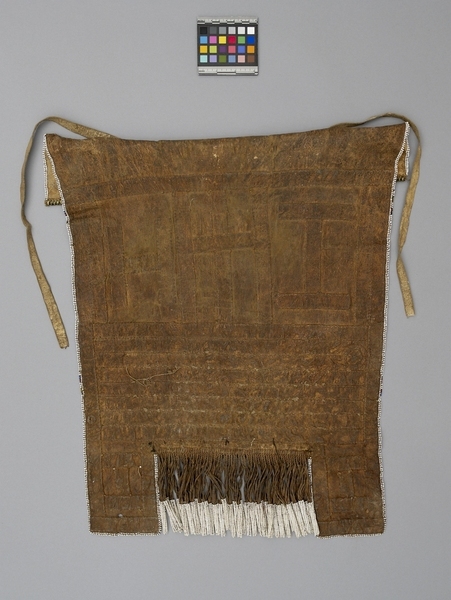Apron Item Number: 2790/5 from the MOA: University of British Columbia


Description
Square beaded hide apron with brass metal rings along edge of flap at waist and two long ties. Beadwork designs in white, red, blue, green and black include patterns in the shape of a capital "I "and "H", a tall cross, and a long, low house. A central bottom fringe, made of twisted bundles of four skin strips encased together at the ends in beadwork tubes, hangs between two panels.
History Of Use
Married woman's apron, liphotu; traditionally made on goatskin, but later also on canvas. It is distinguished from the ijogolo by having two side flaps with beaded tassels hanging in a row between them. According to Powell (in ‘Ndebele: a People and their Art): "Informants confirmed that there was an old symbolism operative here, with the side flaps representing the two marriage partners and the tassels the expectation of the children the woman would bear." Also: 'the liphotu is first worn by the bride at the wedding ceremony...the ijogolo with four or five panels, is worn after women have borne children.'
Item History
- Made in South Africa
- Owned by Lawrence Feuchtwanger before March 3, 2010
- Received from Lawrence Feuchtwanger (Donor) on March 3, 2010
What
- Name
- Apron
- Identification Number
- 2790/5
- Type of Item
- apron
- Material
- glass, animal skin, metal and cotton fibre
- Overall
- height 55.5 cm, width 49.8 cm, depth 4.0 cm
Who
- Culture
- Ndebele
- Previous Owner
- Lawrence Feuchtwanger
- Received from
- Lawrence Feuchtwanger (Donor)
Where
- Holding Institution
- MOA: University of British Columbia
- Made in
- South Africa
When
- Ownership Date
- before March 3, 2010
- Acquisition Date
- on March 3, 2010
Other
- Item Classes
- beadwork; textiles
- Condition
- fair
- Accession Number
- 2790/0005